The iPhone 5 Review
by Anand Lal Shimpi, Brian Klug & Vivek Gowri on October 16, 2012 11:33 AM EST- Posted in
- Smartphones
- Apple
- Mobile
- iPhone 5
Display: Now 16:9 with full sRGB Coverage
Section by Brian Klug
A huge part of the story of what’s new in the iPhone 5 is obviously the display. At a high level what’s different is pretty simple sounding: aspect ratio is now 16:9, resolution is 1136 x 640, gamut coverage is now almost exactly sRGB, and the digitizer is now in-cell as opposed to on-cell. Let’s go through those changes.
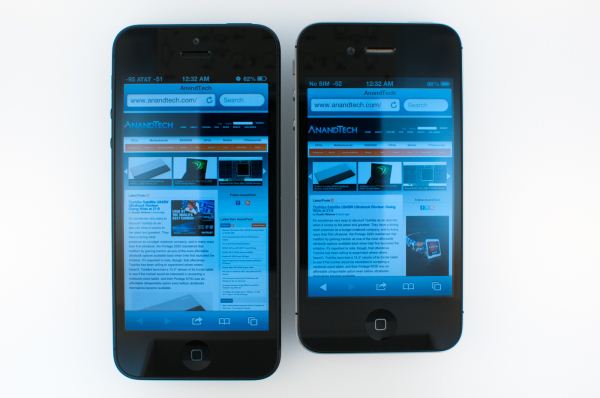
iPhone 5 (left), iPhone 4S (right)
Since the original iPhone days, aspect ratio for the phone has been an immutable 3:2, and later on the iPad adopted an aspect ratio of 4:3. All the while, the aspect ratio wars for content and media have been warring, and by now it’s obvious that 16:9 has won. YouTube changed over to 16:9 just a year after the original iPhone launch, and since then other sources of content have moved that way as well. We saw 16:9 take over as the dominant HD format, and like it or not the same has played out on the PC with a march from 4:3 to 16:10 to 16:9. The move to 16:9 for the iPhone now enables most modern video content to play back without (or with very little) letterboxing, and simultaneously expands the viewport a considerable amount for other applications. A huge number of iOS applications are essentially a list view or a tabbed view with a list down below, and thus are immediately suited in portrait rotation to take advantage of more vertical space. I spend most of my time in portrait mode with rotation locked on iOS, and increasingly it seems as though landscape rotation is a marginalized view for application developers, so this seems to be a sound path forward.
The route Apple chose to get the iPhone to 16:9 is now widely known. They kept width the same at 640 pixels and roughly 5 cm, and instead opted to make the display taller, at 1136 pixels and roughly 8.85 cm, up from 960 pixels and 7.39 cm on the iPhone 4/4S. Interestingly enough 1136 isn’t exactly 16:9, a closer target would be 1137, but we’re talking about one or two pixels that simply get cropped out on video decode and display for most media.
I’ve talked about how Android is now an almost entirely 16:9 camp, and that really frames my thoughts about the iPhone 5’s display size change. In the past, switching back and forth between iOS which was 3:2 previously and modern Android handsets that were 16:9 never felt very extreme. There was a noticeable difference in overall size, sure, but aspect ratio never quite made that big of an impression on me considering the differences in OS. After spending a lot of time with the iPhone 5’s 4-inch, 16:9 display, switching back to the original iPhone format’s 3.5-inch, 3:2 display is a downright jarring experience. It’s readily apparent just how much the platform needed this change in both aspect ratio and size, if nothing else to compete with increasingly larger and larger consumer expectations for display size. It’s interesting as well how discussion about thumb radius sweeping a semicircle out from the bottom corners of the display also quieted down with the change. We’ve talked in the past about how the typical smartphone grip isn’t really centered around the bottom but rather shifted up slightly. I don’t find that the iPhone 5’s larger display changes or diminishes one-handed use significantly at all.
Apple has of course made changes to iOS to accommodate the change in aspect ratio, and those first party applications take advantage of the 176 extra vertical pixels. For starters, the landscape keyboard gets wider keys but doesn’t quite fill up the whole 1136 wide canvas. There’s also another row for applications on homescreens, and another row inside folders.
For third party applications however that road to 16:9 for the iPhone 5 and newest iPod Touch display requires some tweaking, and a trip through the App Store approval process, otherwise you end up with letterboxing. There’s really nothing else that Apple could’ve done besides letterboxing to accommodate older apps that either aren’t updated or will never be updated, but the downside of this centered letterboxed experience is that it shifts portrait apps and the keyboard up by 88 pixels.
A great example of where this is jarring is the IM application I use, imo.im, which hasn’t been updated as of this writing to take advantage of the new viewport size. As a result, typing on this 88-pixel-shifted keyboard requires repositioning one’s grip. This is a temporary grievance though that will go away in time as developers update things, but still warrants mentioning. It’s similar to but not identical to the same kind of friction we saw with the path to retina-enabled apps with the iPhone 4 launch.
In-Cell
The next major improvement is in-cell touch. The iPhone 5 isn’t the first smartphone to include an in-cell touch LCD, but perhaps the first where we’ve seen lots of talk about it. Part of getting to even thinner form factors is either eliminating or reducing the thickness of everything in the z direction. In addition, increasing the light throughput of the display stack (which means both filters and everything between the backlight LEDs and your eye) is a huge driver for overall battery life, since the display is still by far the largest consumer of precious milliwatts in a smartphone.
One of those things is the digitizer, which previously sat on top of the LCD as a separate layer incurring both additional thickness and back reflections. While successive generations of both iPhone display stacks (and the smartphone platform in general) have eliminated a lot of back reflections by reducing the number of air-glass interfaces with optical-grade adhesive lamination (and thus 4 percent Fresnel reflections that go along with each of them), ultimately these glass-adhesive interfaces still incur some path loss and still have a z profile. The only way to reduce these further is to go to in-cell touch, which really is a fancy way of saying that the digitizer is then integrated into the LCD-TFT gating itself, and thus into the cells of each pixel, rather than as a discrete layer atop the stack after color filters.
Getting to this level of integration requires cooperation between both the display driver and touch sensor, and herein lies the challenging engineering problem that in-cell touch poses. Touch sensing has to be time multiplexed with display driving otherwise the touch signal might be entirely lost in noise. At the same time, touch sensing is often around double the frequency (120–175 Hz) of display drawing (60 Hz), so this has to be done carefully during quiet periods, and thus that required communication and integration. The iPhone 5 uses a combination of TI and Broadcom controllers to do display controller and touch sensing, where previous generations of iPhone simply just used a single chip TI solution. In future generations this will come back down to just being a single-chip solution.
Subjectively thus far I haven’t detected any change in tracking quality or performance with the iPhone 5’s in-cell solution, which is great. To end users the difference seems to be totally transparent.
In addition to just the air-adhesive interfaces introducing thickness and unavoidable Fresnel reflections, there’s also the traces from transparent conductors in the digitizer as well to think about. At present that material is Indium Tin Oxide (ITO), which is one of very few known transparent conductors and used inside every LCD. Because Indium is a relatively expensive rare earth metal, ITO traces are only laid down where they need to be on top of and below the glass substrate (for both transmit and receive layers of the digitizer), and the areas inbetween those traces are then filled with an index-matching space fill material to diminish their visibility. How well this space fill is done and how close the index is to ITO’s is one of the quality metrics of a digitizer to begin with, and often these rows and columns are visible under direct illumination either outdoors or with good eyes indoors. Often you can tell a lot about how much value an OEM placed on its entire digitizer just by how distracting these are outdoors, but the big benefit with in-cell is that they go away entirely, which is a huge gain I rarely see people talking about in the context of in-cell improvements.
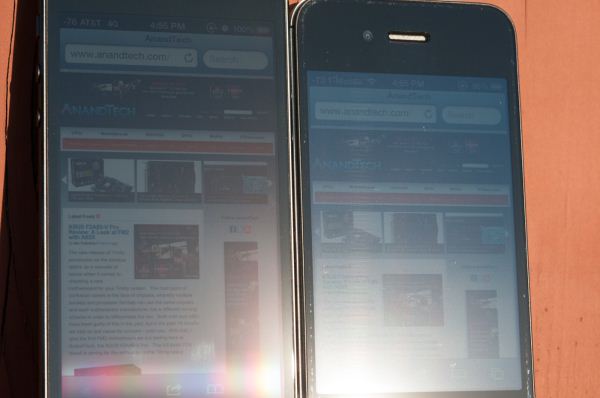
Horizontal lines on the iPhone 4S (right) from the digitizer (easier to see at full size)
That change leads to what I would consider a huge improvement in outdoor visibility, since these lines are now totally gone on the iPhone 5. In addition, there’s no longer a contrast-diminishing set of back reflections from the extra glass layer when outdoors. This is very visible in the photos I’ve taken showing outdoor viewing behavior on both the iPhone 4S and iPhone 5.

Significantly less blue haze on the iPhone 5 (left) than iPhone 4S (right)
Display Quality
Our own Chris Heinonen already did an excellent job characterizing the iPhone 5 display using our new CalMAN 5 based test suite he put together, and I’d encourage everyone to read that for a much more comprehensive version of an iPhone 5 display analysis. There’s really not a whole lot for me to add other than some results from the two other main smartphone displays I’ve tested with this new workflow, and some graphs with data from other phones. Chris has better instrumentation than I do with an i1Pro, but we’ve tweaked the workflow slightly so I ran the iPhone 5 and 4S through the test. In addition Apple has multiple suppliers for the iPhone 5 display so there are bound to be some differences in devices.
Subpixel geometry and size is still the same on the iPhone 5, meaning this is still a “retina” display and all the usual discussion about angular subtense and visual acuity still applies. You can see this under the microscope (all these images are at the same magnification, focus is a bit different though given the different optical path length thanks to that in-cell touch) — both the geometry and pixel pitch are unchanged between the 4S and 5.

To start are our brightness and contrast graphs which are measured at 100 percent brightness. The iPhone is even brighter than the iPhone 4 and 4S displays, at just over 600 nits on my unit. I saw some variance back between the iPhone 4 and 4S in brightness, so depending on where you’re coming from this can be a noticeable jump. Apple started off with good consistency when the iPhone 4 came out, but I saw lots of white point and luminance variance with that form factor display as time progressed and we moved from the 4 GSM to 4 CDMA to 4S.
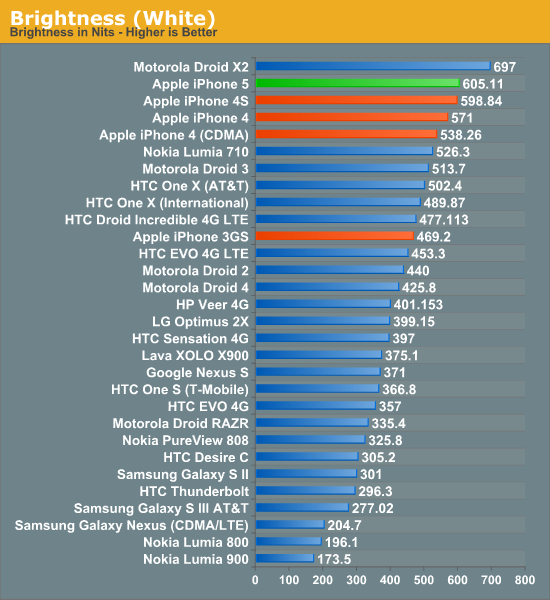
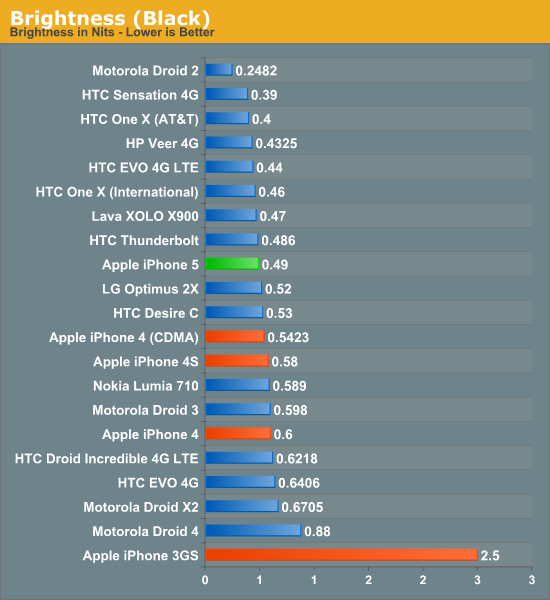
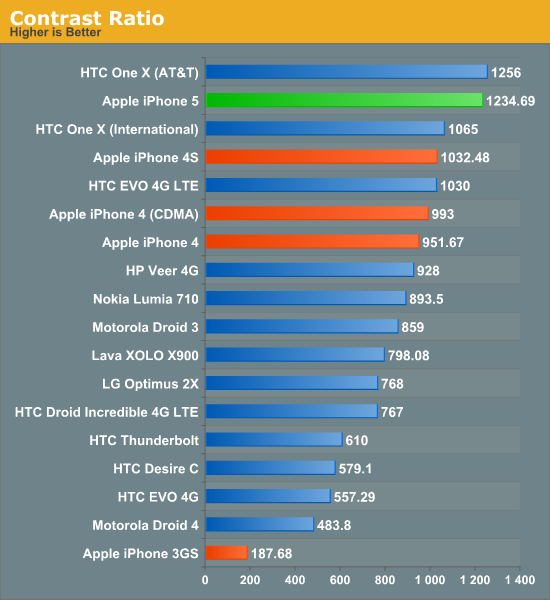
When it comes to gamut, Apple announced that the iPhone 5 display has full sRGB coverage. The iPad 3 was actually first in Apple’s lineup to advertise roughly full sRGB coverage, but it appears that the iPhone 5 is even closer to being spot on. Using our new CalMAN workflow we can easily measure and compare the overall saturations for primaries and secondaries, the ideal values of which are represented by white boxes. There’s a whole lot of measuring required for each phone, so I pared it down to just the iPhone 5, 4S, HTC One X, and Galaxy S 3 for the moment.
Saturations and Gamut
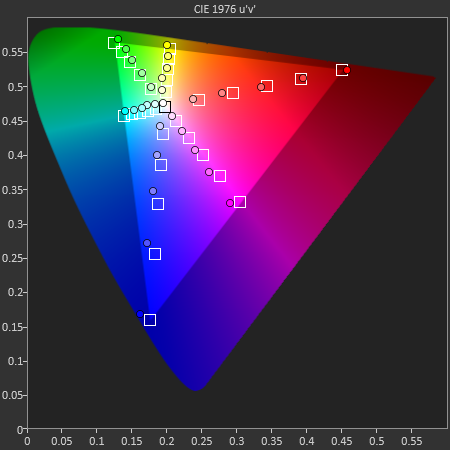
The iPhone 5 is, like Chris said already, the closest smartphone I’ve seen to sRGB to date. It’s really clear to me that Apple puts a strong emphasis on its suppliers to both deliver a display capable of hitting that gamut, and then bothers to do some factory level calibration to get reasonably close. I’ve seen this drift over time but for the time being the iPhone 5 is quite close to being ideal all things considered.
The GretagMacbeth ColorChecker card test colors are next up, and it isn’t surprising here to see some variance, but the values from the iPhone 5 are very close to the intended colors compared to the competition and its predecessor.
GMB Color Checker
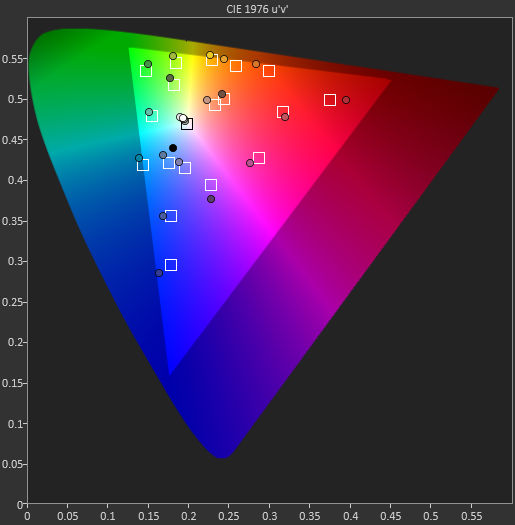
Grayscale and gamma represents our steps of 5 percent grey from 0 to 100 and we get a report for contrast, the white and black levels, color temperature, gamma, and average Delta E 2000 here.
Grayscale and Gamma
My values differ from Chris’ slightly, but my instrumentation and phone are both different from his which may explain some of the differences. The high level story is the same though, the iPhone 5 tracks closer to the ideal than any of the other devices. I’ve also gone ahead and made a table with the average Delta E from each step.
| CalMAN Display Comparison | |||||||
| Metric | iPhone 5 | iPhone 4S | HTC One X | Samsung Galaxy S 3 | |||
| Grayscale 200nits Avg dE2000 | 3.564 | 6.162 | 6.609 | 4.578 | |||
| CCT Avg (K) | 6925 | 7171 | 5944 | 6809 | |||
| Saturation Sweep Avg dE2000 | 3.591 | 8.787 | 5.066 | 5.460 | |||
| GMB ColorChecker Avg dE2000 | 4.747 | 6.328 | 6.963 | 7.322 | |||
Last up is the indoor viewing angles comparison between the iPhone 5 and the 4S, which are essentially unchanged. Even at extreme angles I can’t detect any major differences in viewing angle between the 4S and the 5, which is a good thing since there isn’t really anything to complain about.



















276 Comments
View All Comments
rarson - Thursday, October 18, 2012 - link
Me too, other than the stupid proprietary connection that jacks the price of everything up.Spunjji - Friday, October 19, 2012 - link
I sit pretty firmly in this camp, too. Despite the physical durability flaws, I do find the overall package of the iPhone 4/4S/5 to be superior to most comparable 'Droid handset. I just find the software to be unbearably obstructive to my desired use patterns.steven75 - Wednesday, October 17, 2012 - link
Maybe some people want a still larger display but keep the industry leading app support, industry leading hardware ecosystem, airplay, apple store support, industry leading resale value, industry leading OS upgrade support, and without any carrier bloatware?Seems pretty possible to me.
GotThumbs - Tuesday, October 16, 2012 - link
"we've just got to deal with it." Wrong. You have to "deal with it".Believe it or not....everyone does NOT own one of these phones. The idea of getting a brand new item, be it a car, camera, laptop, tablet or phone and having to deal with the fact that that the companies quality controls are sub-standard is one of the lamest things I've heard....Oh! besides the number one example...... "You're holding if wrong" - Steve Jobs.
I try to not let this kind of monologue that reeks of Apple fanism not bother me...but come on! Talk about romancing about a freaking phone. Please keep it to a level of unemotional comparisons and the feel free to give your personal thoughts and not assume to speak for everyone else.
The fact that you felt compelled to write 5 or more paragraphs on the anodizing process is just pathetic. I stopped reading about it after the first paragraph and skipped to the bottom. I thought this is supposed to be a phone review, not a discovery channel episode on the anodizing process. I can't speak for you or anyone else, but I'm pretty comfortable telling you most consumers probably don't care about the process of anodizing, they just expect a quality product for their money.
People are paying good money...in a bad economy and your saying all they can do is "deal with it"? How about having an open mind and mention they have the choice to buy a different phone or wait for Apple to fix it in their next generation. Your only position appears to be....suck it up, its Apple and thats just part of being in the collective.
Again,,,,, YOU do not speak for everyone so please drop the "WE".
Rant done.
Best wishes to all on your choices in life.
crankerchick - Tuesday, October 16, 2012 - link
Talk about overreaction. Keep the statement within the context of the article. iPhone users have to deal with it if they want to remain iPhone users. Anand is an iPhone user as well are more than a few people reading his review--thus the use of the word "we" instead of the use of the term "iPhone users."That said, he should take care lose the "we" but wow, what a rant for something that one can easily use common sense and say, "No I'm not stuck with it." Other bloggers and review sites do the same thing.
LOL, everyone is always looking for someone to point the fanboy finger at.
KPOM - Tuesday, October 16, 2012 - link
Apparently you have never read an AnandTech review. They go into that kind of detail all the time. That's what people like about them. You aren't going to read that in a CNet, The Verge, or Engadget article. You might get some of that at Ars Technica. But AnandTech goes into excruciating detail.VivekGowri - Tuesday, October 16, 2012 - link
I mean, it's not like Apple is going to radically alter it a month after production starts, so if you want an iPhone 5, your options are to either put a case on it, or suck it up and live with the scratches. Alternatively, you could buy a 4S (if you want iOS) or any other phone that floats your boat.I'm a guy that daily drives a Galaxy Nexus, so accusing me of iOS fanboyism isn't necessarily the most productive way of going about your day.
phillyry - Sunday, October 21, 2012 - link
Yes!Well said Vivek.
But ya, Apple should still have the pressure put on them. So, I could see how people might take it the wrong way. 'Cause it could seem like you're just like, "It's all good Apple, we'll just suck it up." When, in actuality, your ideas are as you stated here. As per the OP's rant, I definitely thought it was off-base but could see where he would draw that conclusion, as it came across that way to me too. And, perhaps like me, he has a hard time keeping track of who uses which phone from the podcasts.
Again, well retorted though.
jiffylube1024 - Tuesday, October 16, 2012 - link
You are seriously complaining about the depth the review went into on the anodizingprocess? You're reading a review of a product and you're complaining that you're being given more information? How about you just skip over that section if it doesn't interest you.
I lol'ed that you called that kind of serious scientific investigation into the anodizing process (which I found incredibly informative) "pathetic". Real, fact-based journalism apparently bores you; you'd just rather read opinion pieces and pass judgment on them. How high minded of you!
Other reviews don't even mention anything about the anodizing process other than that it's there. I don't get why you'd even bother reading a review on AnandTECH if you don't care about the technology...
As for the author's position to "deal with it" (the anodization scratch issue) -- what more can the author do? He can't fix the problem or even address it from a manufacturing standpoint. The review points out the issues with it; the decision making process is up to the consumer and the fixing of the problem is up to the manufacturer.
GotThumbs - Wednesday, October 17, 2012 - link
"Other reviews don't even mention anything about the anodizing process other than that it's there. I don't get why you'd even bother reading a review on AnandTECH if you don't care about the technology..."Anodizing a piece of aluminum does not constitute "technology" when compared to the design of a SoC or camera, at least in my opinion. I see it as a finishing process. My point is that a side link to more detailed information on the anodizing process would have sufficed and kept the reader on track with the hardware review.
I visit Anandtech on a daily basis and have been reading/visiting this site from the early years when Anand was still in High School. I thoroughly enjoy reading/learning about how new technologies in hardware are evolving and when they are compared to other current hardware available in the marketplace. But I feel there has been a growing tendency in Apple product reviews to have a hint of personal/emotional input rather than sticking to an analytical/technical assessment and let each reader digest the information without the personal emotional spin. It's like todays "News" casters interjecting thier personal thoughts/opinions on a news story. I prefer to get the facts and come to my own conclusion.
In case you haven't realized, more and more in todays society, we are "Marketed to" in ways that are growing exponentially. Todays marketing companies continue to market to us using methods not just like Product Placement in TV shows, Reality shows, Movies, Red Carpet runways. etc., but on FB, Twitter, blogs, and weak "tech reviews" like CNN's (Read more like product ads than a review) etc. Because of this bombardment of marketing from every possible source imaginable and newly evolving, I don't think its wrong to call out a reviewer when I feel there is even a whiff of non-neutrality. They can take it with a grain of salt or ponder on their next review to be sure they are approaching it in a clear and unbiased manner.
Complacency in a society and lowering on one's expectations is not something to embrace, its to be challenged and called out.
Listen, no one is perfect and yes I may have been a little high strung in my post, but it was fueled by emotion and passion and I won't apologize for that.
I do apologize to Vivek Gowri if I offended him in any way. It was not my intent.
Best wishes